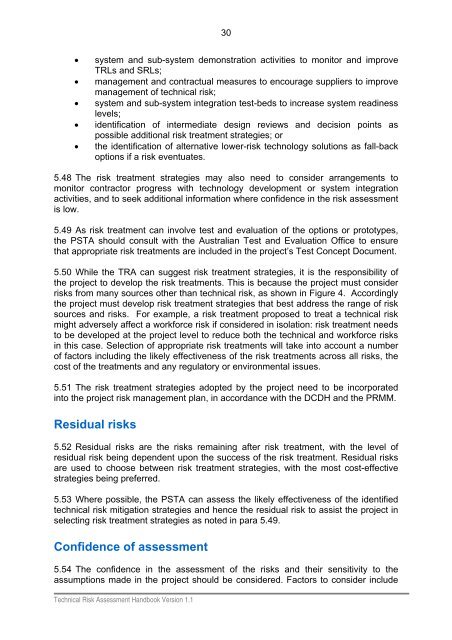Technical Risk Assessment Handbook - Defence Science and ...
Technical Risk Assessment Handbook - Defence Science and ...
Technical Risk Assessment Handbook - Defence Science and ...
You also want an ePaper? Increase the reach of your titles
YUMPU automatically turns print PDFs into web optimized ePapers that Google loves.
30<br />
• system <strong>and</strong> sub-system demonstration activities to monitor <strong>and</strong> improve<br />
TRLs <strong>and</strong> SRLs;<br />
• management <strong>and</strong> contractual measures to encourage suppliers to improve<br />
management of technical risk;<br />
• system <strong>and</strong> sub-system integration test-beds to increase system readiness<br />
levels;<br />
• identification of intermediate design reviews <strong>and</strong> decision points as<br />
possible additional risk treatment strategies; or<br />
• the identification of alternative lower-risk technology solutions as fall-back<br />
options if a risk eventuates.<br />
5.48 The risk treatment strategies may also need to consider arrangements to<br />
monitor contractor progress with technology development or system integration<br />
activities, <strong>and</strong> to seek additional information where confidence in the risk assessment<br />
is low.<br />
5.49 As risk treatment can involve test <strong>and</strong> evaluation of the options or prototypes,<br />
the PSTA should consult with the Australian Test <strong>and</strong> Evaluation Office to ensure<br />
that appropriate risk treatments are included in the project’s Test Concept Document.<br />
5.50 While the TRA can suggest risk treatment strategies, it is the responsibility of<br />
the project to develop the risk treatments. This is because the project must consider<br />
risks from many sources other than technical risk, as shown in Figure 4. Accordingly<br />
the project must develop risk treatment strategies that best address the range of risk<br />
sources <strong>and</strong> risks. For example, a risk treatment proposed to treat a technical risk<br />
might adversely affect a workforce risk if considered in isolation: risk treatment needs<br />
to be developed at the project level to reduce both the technical <strong>and</strong> workforce risks<br />
in this case. Selection of appropriate risk treatments will take into account a number<br />
of factors including the likely effectiveness of the risk treatments across all risks, the<br />
cost of the treatments <strong>and</strong> any regulatory or environmental issues.<br />
5.51 The risk treatment strategies adopted by the project need to be incorporated<br />
into the project risk management plan, in accordance with the DCDH <strong>and</strong> the PRMM.<br />
Residual risks<br />
5.52 Residual risks are the risks remaining after risk treatment, with the level of<br />
residual risk being dependent upon the success of the risk treatment. Residual risks<br />
are used to choose between risk treatment strategies, with the most cost-effective<br />
strategies being preferred.<br />
5.53 Where possible, the PSTA can assess the likely effectiveness of the identified<br />
technical risk mitigation strategies <strong>and</strong> hence the residual risk to assist the project in<br />
selecting risk treatment strategies as noted in para 5.49.<br />
Confidence of assessment<br />
5.54 The confidence in the assessment of the risks <strong>and</strong> their sensitivity to the<br />
assumptions made in the project should be considered. Factors to consider include<br />
<strong>Technical</strong> <strong>Risk</strong> <strong>Assessment</strong> <strong>H<strong>and</strong>book</strong> Version 1.1

















